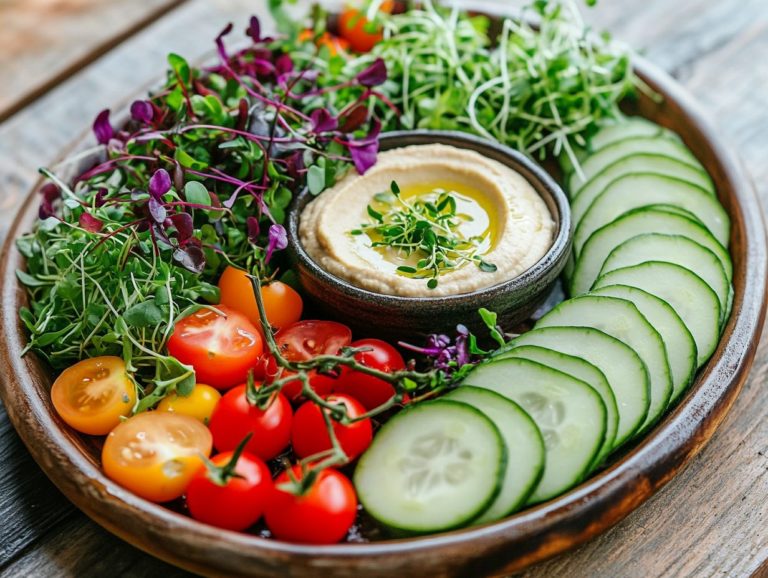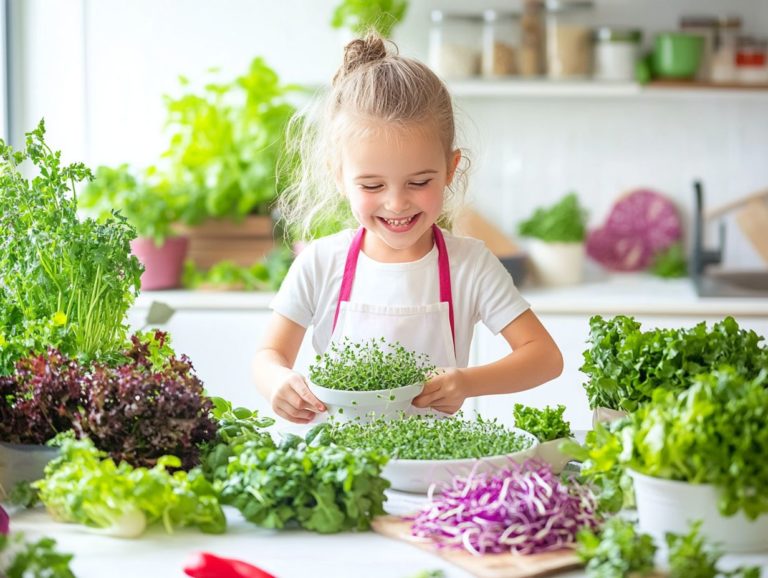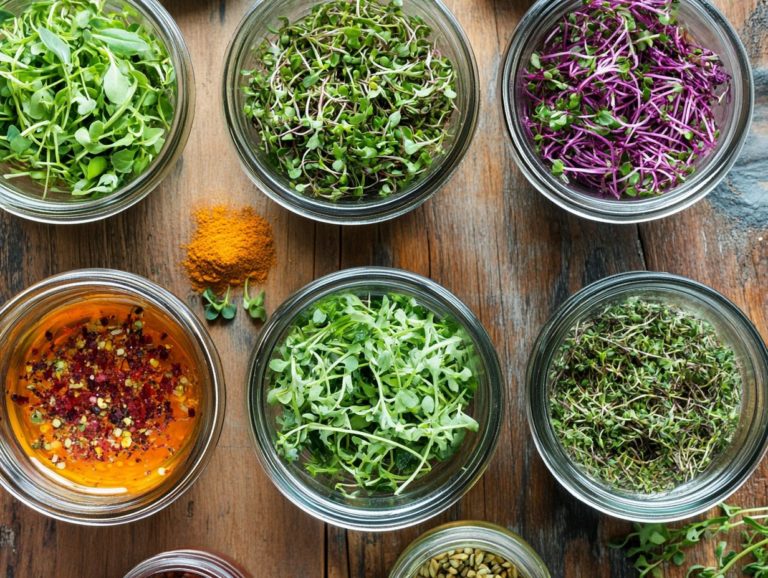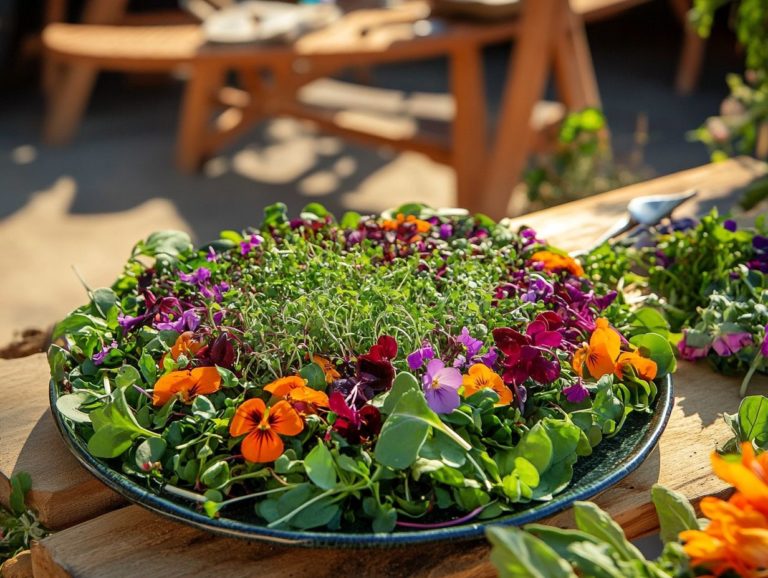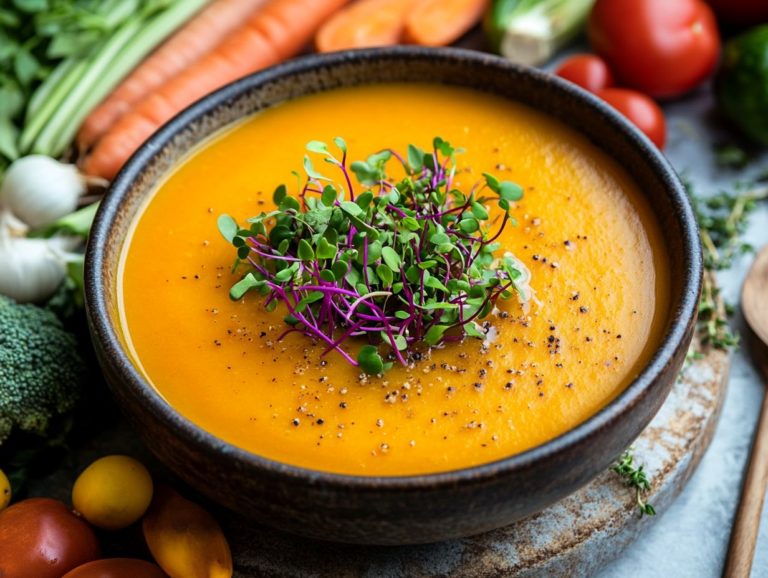94. How to Use Microgreens in Creative Casseroles
Microgreens are remarkable little powerhouses of flavor and nutrition. They can truly elevate your culinary creations.
This article delves into the myriad benefits of incorporating microgreens into casseroles. You’ll see how they enhance not only the nutritional value but also the flavors and presentation of your dishes.
Discover the best types of microgreens to use, along with essential cleaning and storage tips. Learn innovative ways to weave them into your favorite recipes.
Get ready to transform your casseroles and delight your taste buds like never before!
Contents
- Key Takeaways:
- Benefits of Using Microgreens in Casseroles
- Choosing and Preparing Microgreens for Casseroles
- Creative Ways to Incorporate Microgreens in Casseroles
- Tips for Adding Microgreens to Your Casserole Cooking Routine
- Frequently Asked Questions
- 1. What are microgreens and how can I use them in creative casseroles?
- 2. Can I use any type of microgreens in casseroles?
- 3. How do I store microgreens for later use in casseroles?
- 4. Can I cook microgreens in casseroles?
- 5. Are there any specific types of casseroles that pair well with microgreens?
- 6. Are microgreens only used as a garnish in casseroles?
Key Takeaways:
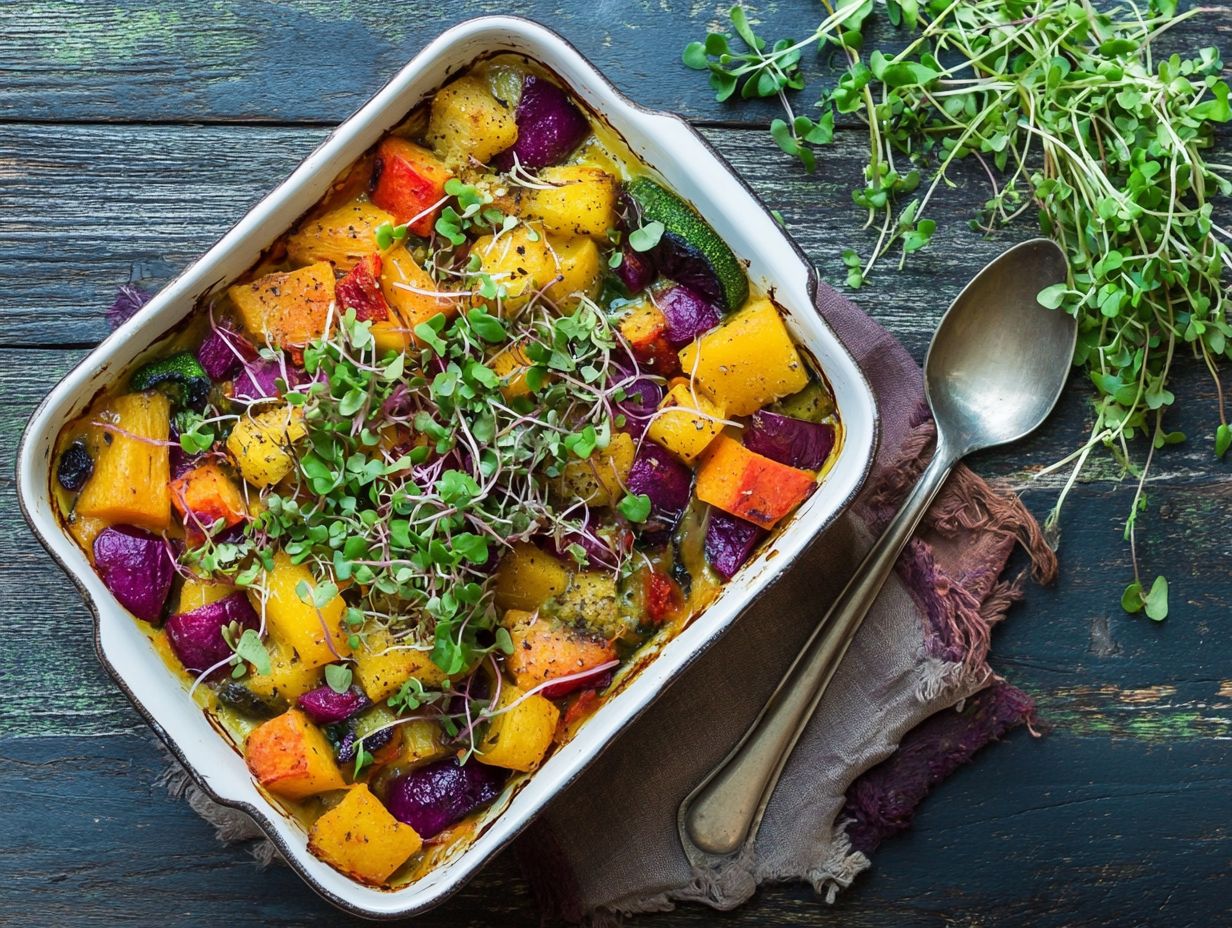
- Mix things up and add a new twist to your traditional casseroles with microgreens.
- Microgreens add flavor and aesthetic appeal while packing a punch of nutrients, elevating the nutritional value of your dishes.
- With proper preparation and selection, microgreens can be versatile and creative ingredients, adding color and texture to your casseroles.
What are Microgreens?
Microgreens are delightful little plants harvested just after the first true leaves develop. They bring a variety of flavors and textures that can elevate your dishes.
These petite greens are very nutritious plants, making them ideal for salads, sandwiches, and various meals.
Packed with vitamins, minerals, and antioxidants, microgreens like basil and onion tantalize your taste buds while contributing to your health and wellness.
Whether used as toppings on tacos or garnishes for soups and cocktails, their vibrant colors and crunchy textures make a statement in any culinary masterpiece.
Among the diverse family of microgreens, you’ll find radish with its spicy flavor and beet microgreens, celebrated for their earthy sweetness and striking magenta hue.
Growing these greens is straightforward; they require minimal space and thrive indoors with just water and light. Culinary enthusiasts often incorporate microgreens into dishes like pesto and dressing or toss them into grain bowls, enhancing both flavor and visual appeal.
The health benefits are impressive, too, as many microgreens contain higher concentrations of nutrients than their mature counterparts.
From adding a flavorful basil touch to your Caprese salad to providing a refreshing crunch of cilantro on tacos, the versatility of microgreens makes them beloved ingredients in kitchens everywhere.
Benefits of Using Microgreens in Casseroles
Integrating microgreens into your casseroles elevates the flavor and significantly enhances the nutritional value of your dishes. These vibrant greens bring unique flavor profiles that add depth and complexity to traditional casserole recipes.
By incorporating microgreens like basil or arugula, you can transform an ordinary family meal into a culinary delight. You can effortlessly include more fresh vegetables in your diet.
Their rich nutrient content supports your overall health and wellness, ensuring every bite is delicious and beneficial.
Try adding microgreens to your next casserole and taste the difference!
Nutritional Benefits
Microgreens are a powerhouse of nutrition, brimming with vitamins, minerals, and antioxidants that can elevate your overall health. Research shows these tiny greens often have more nutrients than mature plants, making them a stellar addition to salads, sandwiches, and beyond.
Take broccoli and kale microgreens, for example; they re loaded with vitamins A, C, E, and K. Others bring essential minerals and anti-inflammatory properties to the table. By weaving microgreens into your meals, you can effortlessly boost your nutrient intake without sacrificing flavor.
Studies show that varieties like radish microgreens are impressive because they contain a compound called sulforaphane, known for fighting cancer. When you compare the nutrient profiles of microgreens to mature plants, you ll see that, on average, these tiny greens can contain up to 40 times more nutrients, underscoring their exceptional status as a superfood.
This is especially beneficial if you re looking to enhance your diet without piling on extra calories. The vibrant colors and diverse flavors of microgreens not only enhance your culinary creations but also inspire healthier eating habits, making them a delightful and nutritious addition to a wide array of dishes.
Flavor and Aesthetic Enhancements
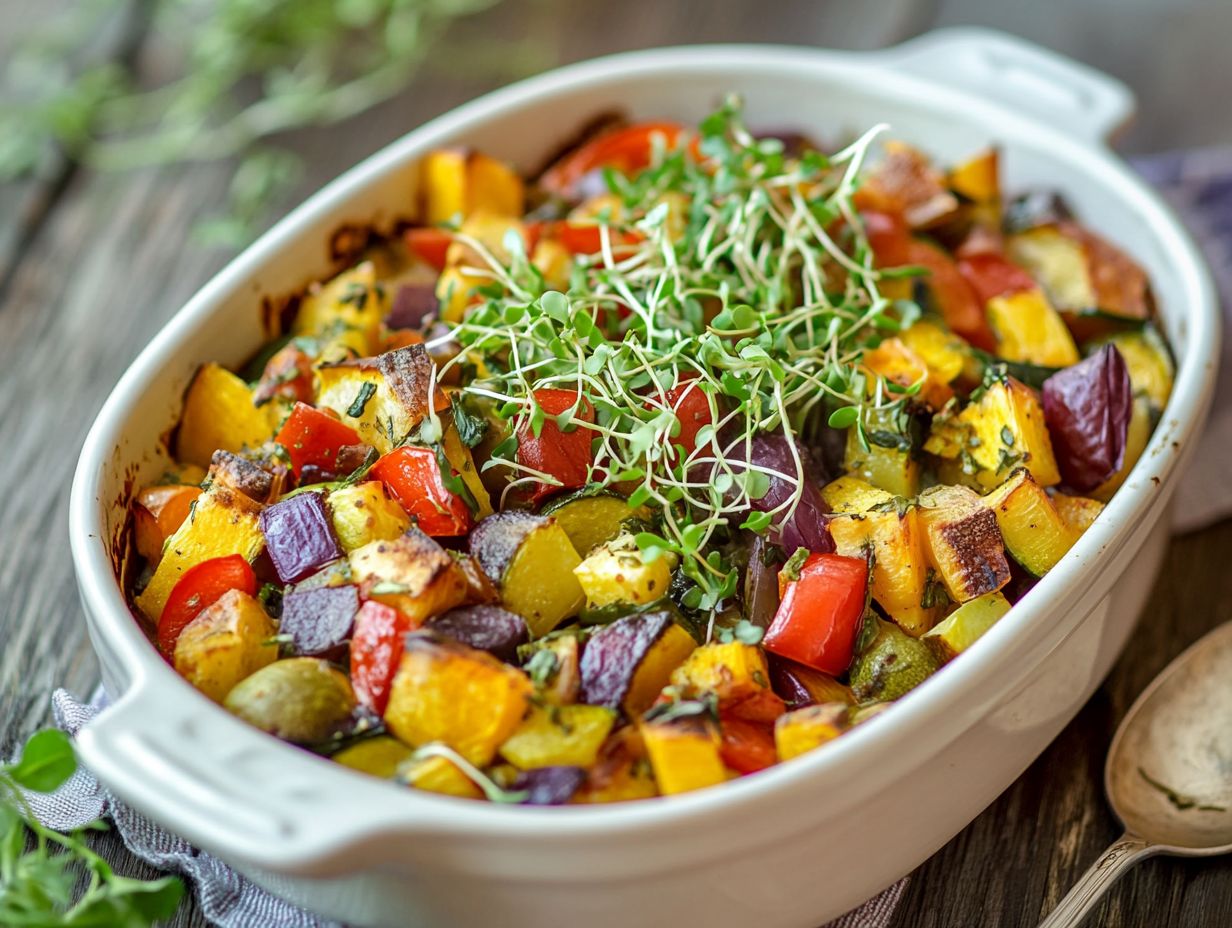
Using microgreens in your cooking not only elevates the flavor of your dishes but also adds a striking aesthetic appeal that enhances visual presentation. These vibrant greens burst with flavors, from the peppery kick of arugula to the sweet notes of basil giving you the freedom to experiment with unique combinations in salads, pastas, and casseroles.
The visual contrast created by adding microgreens transforms meals into a feast for the eyes, making them more inviting and appetizing. By incorporating these tiny greens, you can turn simple dishes into gourmet experiences that delight both the palate and the eye.
These little powerhouses are packed with nutrients, contributing not just to taste but also to the healthfulness of your meals. Imagine artfully scattering a handful of microgreens atop a plate of risotto or grilled fish, introducing vibrant splashes of color that bring your dish to life.
Each variety offers a distinct flavor note, allowing you to express your culinary creativity in ways that surprise and please your diners. As these culinary gems find their way into more kitchens, their role in enhancing both flavor and presentation truly shines, making them critical for anyone looking to refine their cooking aesthetics.
Choosing and Preparing Microgreens for Casseroles
Selecting the right microgreens and preparing them meticulously is key to enhancing the flavor and nutritional profile of your casseroles. Opting for fresh, vibrant microgreens can truly elevate your dish, while employing proper cleaning and storage techniques ensures they retain their quality and taste.
When gearing up for your casseroles, consider microgreens such as basil, arugula, or onion, as they beautifully complement traditional flavors. Knowing how to clean and store microgreens helps preserve their nutrients and freshness, making them a critical ingredient in your culinary repertoire.
Best Types of Microgreens to Use
When you’re incorporating microgreens into casseroles, selecting the right types can dramatically enhance both flavor and texture.
Popular options like basil, arugula, and radish microgreens stand out for their distinctive flavors and versatility, making them perfect for a variety of dishes.
By familiarizing yourself with the unique characteristics of each type, you can craft meals that are not only delicious but also visually striking.
Exploring different combinations of microgreens can lead to exciting flavor profiles that elevate your favorite casserole recipes.
For example, basil microgreens impart a sweet, aromatic flavor that complements cheesy, tomato-based casseroles, taking classic Italian dishes to the next level.
Arugula microgreens, with their peppery kick, provide a bold contrast in creamy or savory casseroles, making them ideal for root vegetable blends.
Meanwhile, radish microgreens add a crisp, zesty punch that can invigorate heavier mixtures, creating a delightful balance.
Don’t overlook sunflower microgreens, which offer a nutty flavor that’s perfect for vegetarian casseroles.
Pea shoots bring a refreshing touch that pairs beautifully with layers of meat or grains.
These fantastic selections will thrill your taste buds and supercharge your meals!
Proper Cleaning and Storage Techniques
Proper cleaning and storage techniques for microgreens are essential for maintaining their freshness and healthy benefits, ensuring they bring maximum flavor to your casseroles.
Gently rinse your microgreens under cold water and pat them dry with a paper towel; this removes any dirt or debris without compromising those delicate greens.
After cleaning, store your microgreens in a breathable container, ideally lined with a damp paper towel, to extend their shelf life and keep them crisp.
These straightforward yet effective techniques can truly elevate your culinary creations featuring microgreens.
For optimal quality, consider using a salad spinner to dry them.
This method effectively removes excess moisture that could lead to spoilage.
Once your microgreens are clean and dry, placing them in a perforated plastic bag will promote air circulation, further enhancing their longevity.
Keep them refrigerated at a stable temperature, and steer clear of storing them near ethylene-producing fruits, which can accelerate wilting.
By employing these thoughtful methods, you not only enhance the taste and presentation of your dishes but also maximize the health benefits that fresh microgreens provide.
Creative Ways to Incorporate Microgreens in Casseroles
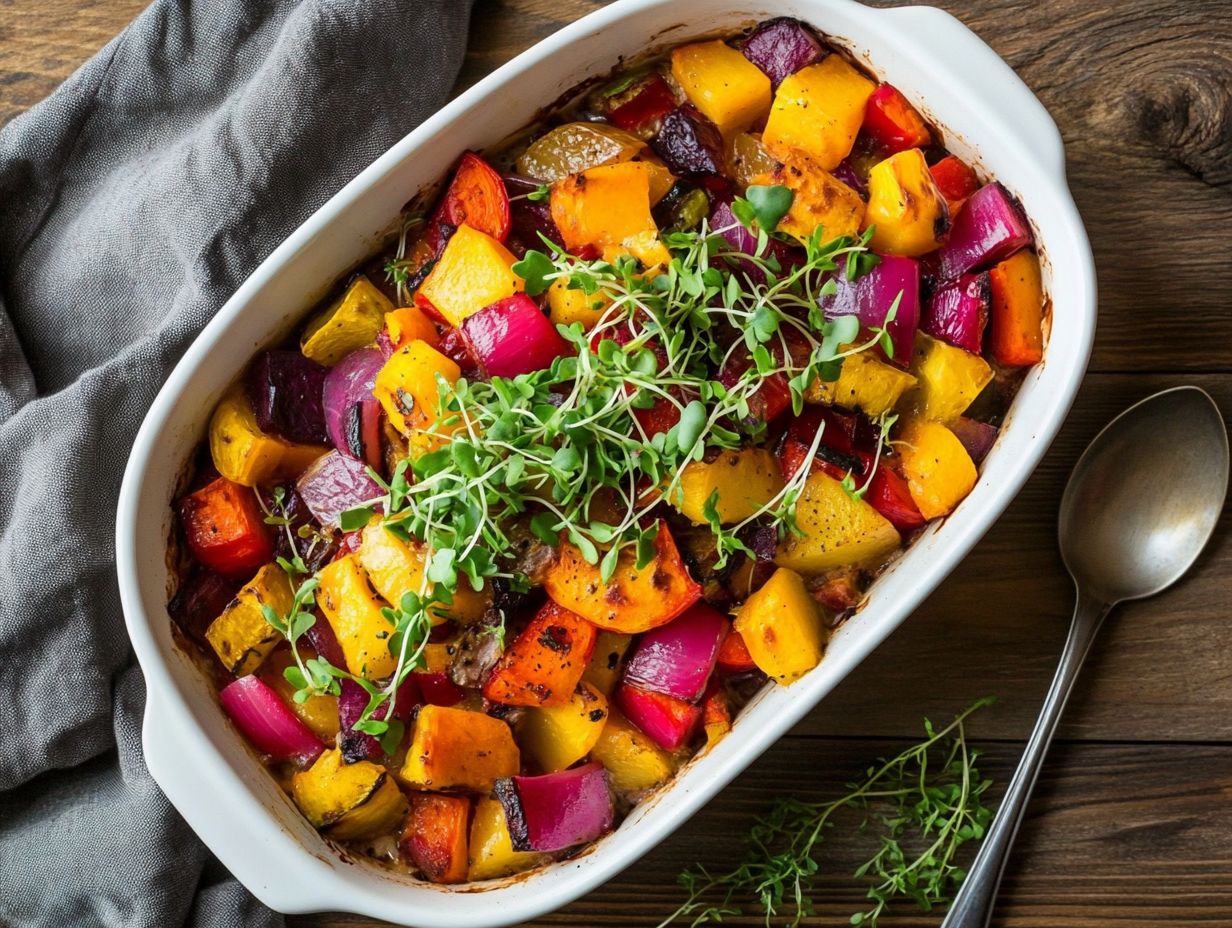
Exploring creative avenues to incorporate microgreens into casseroles can elevate traditional recipes into extraordinary culinary experiences.
Imagine layering fresh microgreens between ingredients or using them as vibrant toppings; the possibilities for innovation are truly limitless.
Microgreens introduce unique flavors and textures to comfort foods, transforming meals into not only healthier options but also visually captivating presentations.
Dive into the fun of experimenting! Blend microgreens into sauces for an extra nutritional boost or sprinkle them atop baked dishes just before serving to enhance both taste and visual appeal.
Try layering your favorite microgreens for a mouthwatering twist on your casserole tonight!
Recipes and Ideas for Different Types of Casseroles
You can elevate a wide variety of recipes with microgreens. Imagine enhancing a classic vegetable casserole with a layer of fresh basil microgreens. You could also infuse a hearty chicken casserole with the peppery notes of arugula mixed into the filling.
Integrating microgreens as a garnish boosts visual appeal and adds fresh flavor to your dishes. The possibilities for delicious casseroles are endless.
Consider incorporating other microgreens like radish or mustard to introduce a zesty crunch to your traditional recipes. For instance, a cheesy broccoli and quinoa casserole can come alive with a topping of spicy radish microgreens, providing both texture and a burst of color.
When preparing tuna noodle casserole, think about folding in pea shoots to complement the savory flavors while adding a touch of sweetness. These variations enhance taste and pack a nutritional punch, transforming simple dishes into gourmet experiences.
Tips for Adding Microgreens to Your Casserole Cooking Routine
Incorporating microgreens into your casserole cooking routine can truly transform your culinary experience, offering both health benefits and delightful flavor enhancements with little effort.
Begin by gradually introducing microgreens into your favorite recipes. Experiment with various types and combinations to find what excites your taste buds. Keep in mind the cooking time; adding delicate microgreens towards the end of the cooking process helps them retain their nutrients and vibrant flavor.
With these insights, you can effortlessly elevate your dishes and savor the unique advantages that microgreens bring to your table.
How to Experiment and Customize with Microgreens
Experimenting with microgreens in your dishes opens up a world of culinary possibilities that can elevate both flavor and nutrition.
As you dive into the bold notes offered by various microgreen varieties, think about pairing them with distinctive ingredients to enhance your favorite recipes. For example, incorporating peppery arugula microgreens into a lemon-infused pasta dish can introduce a refreshing zest. Consider swapping out traditional salad greens for a blend of delicate basil microgreens, creating a delightful twist that highlights their aromatic qualities. If you’re looking for more ideas, check out this guide on How to Incorporate Microgreens into Your Diet.
The secret lies in thinking outside the box and letting your palate take the lead. Whether you’re looking to add subtle sweetness with sunflower microgreens or a vibrant burst of color with red cabbage varieties, the potential for unique combinations is limitless. With a little creativity, you can transform ordinary meals into extraordinary culinary experiences.
Frequently Asked Questions
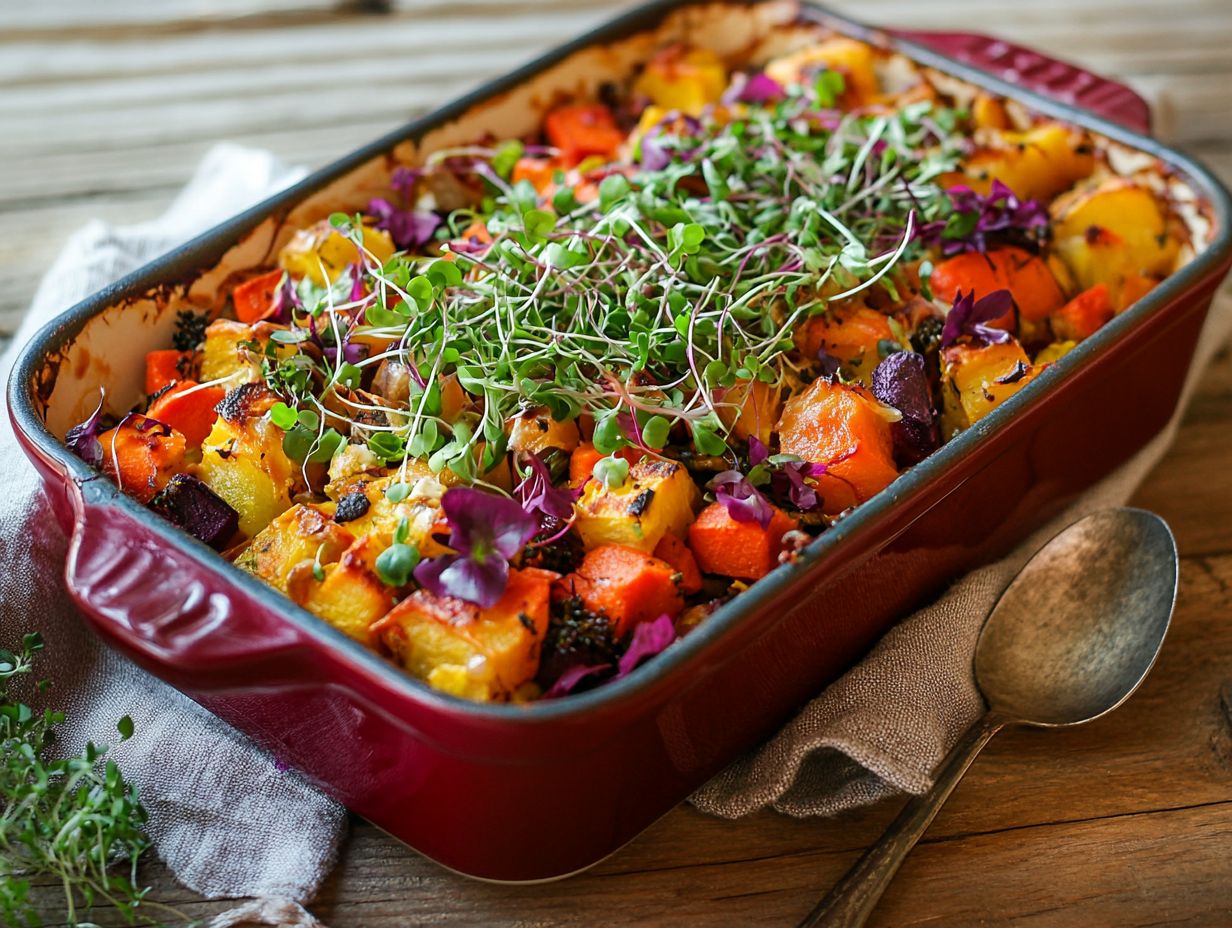
1. What are microgreens and how can I use them in creative casseroles?
Microgreens are young plants harvested just inches tall. They re flavorful and nutritious, perfect for casseroles. Just sprinkle them on top before serving.
2. Can I use any type of microgreens in casseroles?
Yes, you can use any type of microgreens in casseroles. Some popular varieties include broccoli, radish, sunflower, and pea shoots. Try different types now to find your favorites!
3. How do I store microgreens for later use in casseroles?
To store microgreens, rinse and pat them dry with a paper towel. Place them in an airtight container or bag in the refrigerator. They should stay fresh for up to a week.
4. Can I cook microgreens in casseroles?
It is not recommended to cook microgreens in casseroles as they are delicate and can lose their nutritional value when heated. Add them to the casserole after it has been cooked.
5. Are there any specific types of casseroles that pair well with microgreens?
Microgreens can be used in various casseroles, from breakfast casseroles to pasta bakes. They add a burst of flavor and color to any dish, so feel free to get creative and add them to your favorite recipes.
Don’t miss out on the chance to elevate your casseroles with microgreens! With a little creativity and experimentation, you can enhance your culinary experiences and enjoy the many benefits they bring.
6. Are microgreens only used as a garnish in casseroles?
No, microgreens are versatile and can be a main ingredient in casseroles.
These tiny, nutrient-packed greens make a fantastic substitute for spinach or other leafy greens, adding an exciting twist to your favorite recipes!

